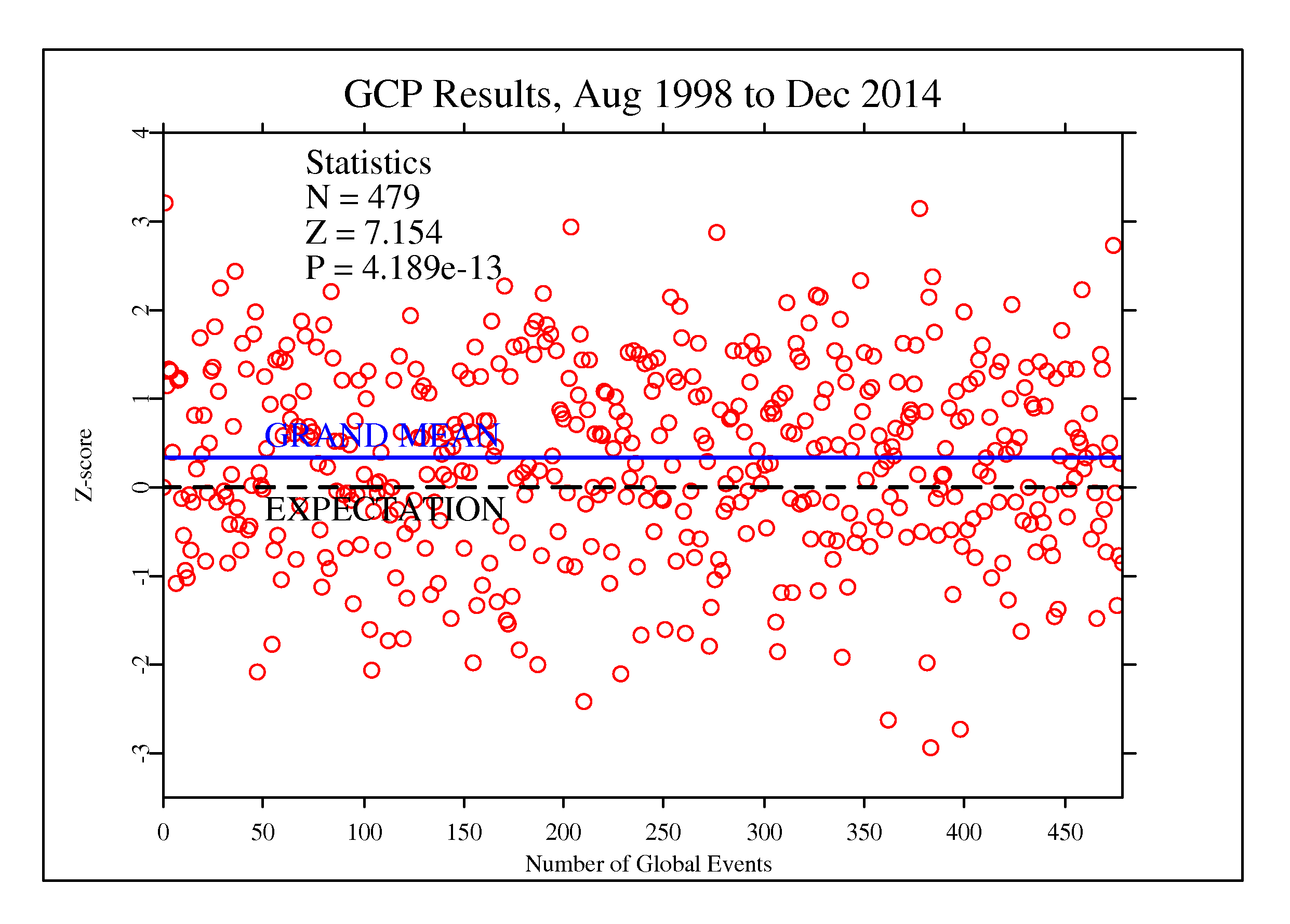What is the Global Consciousness Project?
For the many people who feel interested, but don't find the time to read the website or published papers, this is an introduction to the Global Consciousness Project (GCP) and what we have learned over more than 15 years of serious research. We begin with a very brief overview of findings, which do actually need background and detail to be properly understood, but I am sympathetic to the desire to get to the point.
The rest of the GCP website will sharpen that point and put flesh on the interesting bottom line bones. First, a three minute news item gives a simple but lively introduction: Brian Keefe, CBS2 Interview.
In the smallest nutshell:
The behavior of our network of random sources is correlated with interconnected human consciousness on a global scale.
There is a highly significant overall effect on the GCP instrument (more on that below) during special times we identify as global events
when great numbers of people experience shared emotion. The effect is a tiny statistical deviation from an expected randomness, but the patient replication of tests has gradually created very strong statistical support for the reality of a subtle correlation of human consciousness with deviations in random data. The probability that the effect could be just a chance fluctuation is less than 1 in a trillion, an impressive bottom line statistic that is composed of small effects accumulated in more than 450 tests. The correlation is subtle, so much so that individual event results are too weak to be reliably interpreted. Yet, because we are able to measure combined results across many replications, we overcome a very small signal to noise ratio—real effects gradually accumulate, while the unstructured noise is self-canceling.
The GCP instrument is a network of random number generators (RNGs, sometimes called REGs) spread around the world. There are currently about 65 or 70 nodes in the network, and at each one, random data trials are recorded continuously, one trial per second, day after day over the past 16 years. The result is a database of synchronized parallel sequences of random numbers. The data are archived on a server in Princeton, and subjected to formal analysis testing whether there are departures from expected randomness corresponding to global events.
The GCP effects are not seen primarily as deviations of the individual RNGs (which we often call eggs
), but can be seen as an increase in the average correlation between pairs of eggs separated by distances up to thousands of kilometers. This means that although the direct effects are too small for us to detect, they occur in synchrony and this leads to detectable changes in the network as a whole. By definition the eggs are independent and should not show any relationship at all. But during moments of importance to humans, the devices show slight correlations with each other. This is a fact that does not fit readily into scientific models, so understandably it is a fact that remains to be accepted. It presents a challenge to status quo physics and psychology. When and as the data are brought into perspective, they may help place mind and consciousness in more broadly competent models of the world.
There are other measures of structure in the data. Independent analysts have been able to identify a significant effect of distance, though not in the measure of distance between event and the REGs. Rather, analysis shows that the pairwise correlations—links between pairs of REGs—are weaker for large distances, dropping to zero at about 12,000 kilometers, roughly the earth diameter. There is also a characteristic temporal structure. The effects, on average, only become significant when we have data sequences of half an hour or more, and the effect persists for only a few hours, up to about 3 or 4 hours. This suggests that a moment
in global consciousness is somewhat like a moment in individual consciousness, but with a time scale that is vastly different. A perception takes less than a second in my mind. For an effect of global consciousness to show up in our data as detectable structure it appears to require half an hour or more. The difference is a factor of at least 1,000, maybe as much as 10,000.
Another, possibly more profound and directly important finding is that the effects we see influenced by factors that are familiar from human psychology. For example, the effects are larger in proportion to the importance of the events we examine, and they are larger if the level of emotional involvement is high. We see stronger effects when events embody or evoke deep feelings of compassion, but smaller effects when the level of fear is high. That last point seems counterintuitive to many, but upon consideration, the relationships make sense and they bear strong implications for us. Compassion is an interpersonal, connecting emotion, while fear drives us toward personal survival; it separates us.
There are many details, but this outlines the major findings. The bottom line is that something associated with mass consciousness is changing the physical world—our network of physical random number generators. We don't have full-fledged explanations yet, but the database accumulated over years is rich. It holds information that should lead to understanding, not only of the GCP effects, but to a richer, more comprehensive view of consciousness.
A complete presentation of the formal results includes details for all events and summaries.

